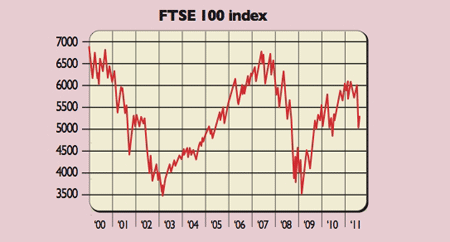
Investors who obeyed the old market dictum ‘Sell in May’ did well this year. Britain’s FTSE 100 has fallen by around 15% since the end of April. But following the second part of the adage – come back on St Leger’s day (the mid-September horse race) – doesn’t look like a good idea this time round. Neither the short- nor the long-term outlook for the blue-chip index is promising.
While a recession is looking increasingly likely in the developed world, the market is pricing in only a gentle growth slowdown. “In previous recessions analysts downgraded earnings forecasts far more than they have in the past few months,” says James Mackintosh in the FT. And “shares tend to move roughly in line with the proportion of upgrades”. That spells trouble. Analysts are currently pencilling in very optimistic earnings growth of 14% and 12% for the wider British market over the next two years.
The broader issue is that markets have become aware of “the sheer intractability of the growth/debt conundrum” in the developed world, says Tom Stevenson in The Sunday Telegraph. Paying down debt “kills off the growth; fixing the growth means the debts balloon”. This helps explain why the reaction to last week’s $450bn US jobs plan, which is likely to be watered down in any case by political wrangling, was so muted. While the developed world faces years of sub-par growth as debt gradually getsworked off, there is the ever-present threat of another banking crisis as the euro comes unstuck.
Given how previous financial crises have panned out, it is likely to be “many years before things are back on an even keel”, says market historian David Schwartz in the FT. That suggests that the choppy sideways trading, or market falls, seen since the turn of the millennium – the FTSE has fallen in that period by 24% – will continue. Indeed, it’s noteworthy that there is “a strong tendency for abnormally large gains in any 15-year period to be followed by losses in the next 15 years”. This trend “ran for at least two centuries with no exceptions”.
The years before the turn of the century saw an unparalleled upswing, says Schwartz. In the 1980s and 1990s the market rose 1,000%. It’s now payback time. Given that the years from 1986 to 2001 saw above-average returns, expect the FTSE to end 2016 below 5,242, its level at the end of 2001.